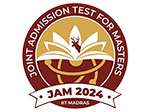Indian Institute of Technology Joint Admission Test for Masters
For two decades, the Joint Admission Test for Masters (JAM) has set a standard for undergraduate-level science education in India. JAM’s aim is to admit students into postgraduate degree programs and promote science as a promising career choice nationwide. These programs offer world-class education in various fields, nurturing academic excellence and preparing students for rewarding professional lives. The interdisciplinary nature of the curriculum equips students to apply scientific knowledge practically. These programs are open to eligible candidates of all nationalities, with English as the medium of instruction. To seek admission to specific postgraduate programs for the academic year 2024-25, candidates must take the JAM 2024 Examination, and there are no age restrictions.
Admission Procedure through IIT JAM
Based on the test paper(s) qualified, an applicant can apply to one or more academic programmes covered under that test paper(s), subject to fulfilment of the Minimum Educational Qualifications (MEQs) and the Eligibility Requirements (ERs) of the Admitting Institutes. After the JAM results are announced, a qualified candidate should apply ONLINE only using the prescribed Admission Form available at the JOAPS website, irrespective of the Institute where the admission is sought.
Eligibility Criteria for IIT JAM 2024
Eligibility for IIT JAM 2024 in simple terms: You need to have completed your undergraduate degree or be in your final year of the program. You must provide proof of passing your qualifying degree with the required eligibility, as specified by the institute you’re applying to. If you were promoted to the next semester/year without receiving a marksheet, you’ll need to provide a certificate signed by your institute’s Head, stating the subjects you studied. Foreign nationals with an Indian degree can also apply, but they need to check the specific policy of the institute they’re interested in.
No. of Seats in IIT Delhi and IIT Roorkee
IIT Delhi offers a total of 25 seats while IIT Roorkee offers 33 seats
Fees for IIT Institutes
Please be aware that the fees for the program may differ from one institute to another. To get the exact fee details for your chosen institute, it’s advisable to visit the official website of that institute. This will ensure you have the most accurate and current information about the fees.
IIT JAM Entrance Exam Syllabus
Microeconomics
Consumer theory: Preference, utility, budget constraint, choice, demand, Slutsky equation, revealed preference axioms. Theory of production and cost: Production technology, isoquants, returns to scale, short run and long run costs, cost curves. General equilibrium and welfare: Equilibrium, efficiency, welfare economics. Market structure: Perfect competition, monopoly, price discrimination, monopolistic competition, oligopoly. Game theory: Strategic form games, Nash equilibrium, mixed extension, Prisoner’s dilemma. Public goods and market failure: Externalities, public goods, asymmetric information.
Macroeconomics
National income accounting: Concepts, measurements, fiscal and foreign sector variables.Behavioural and technological functions: Consumption functions, investment functions, money demand and supply.Business cycles and economic models: Classical model, Keynesian model, IS-LM Model, Hicks’ IS-LM synthesis, monetary and fiscal policies. Inflation and unemployment: Theories, measurement, causes, effects. Growth models: Harrod-Domar, Solow, Neo-classical growth models.
Statistics for Economics
Probability theory: Sample space, events, random variables, probability distributions, expectation, variance, functions of random variables. Mathematical statistics: Random sampling, estimation, hypothesis testing, correlation, regression. Hypothesis testing: distributions of test statistics, testing hypotheses related to population parameters, Type I and Type II errors, the power of a test, tests for comparing parameters from two samples. Correlation and regression: Correlation and types of correlation, the nature of regression analysis, method of Ordinary Least Squares (OLS), CLRM assumptions, properties of OLS, goodness of fit, variance and covariance of OLS estimator
Indian Economy
Indian economy before 1950: Transfer of tribute, deindustrialization. Planning and Indian development: Planning models, challenges. Indian economy after 1991: Balance of payments crisis, economic reforms. Banking, finance, and macroeconomic policies: Banking, financial sector reforms, fiscal and monetary policy, savings and investment. Inequalities in social development: Achievements, disparities between Indian States. Poverty: Methodology, issues in poverty estimation. India’s labour market: Unemployment, labour force participation rates.
Mathematics for Economics
Preliminaries and functions: Set theory, elementary functions, sequences and series, complex numbers. Differential calculus: Limits, continuity, differentiability, mean value theorems, partial differentiation, higher order derivatives, implicit function theorem. Integral calculus: Definite integrals, fundamental theorems, indefinite integrals. Differential equations, and difference equations: First order difference equations, first order differential equations. Linear algebra: Matrix representations, systems of linear equations, linear independence, determinants, eigenvectors and eigenvalues, symmetric matrices. Optimization: Local and global optima, multivariate optimization, constrained optimization, linear programming.
Please note that this is a summarized version of the syllabus.
IIT JAM 2024 Paper Pattern
The exam will last for 3 hours. It will be conducted in English only. There will be a total of 60 questions, and they will be divided into three sections: A, B, and C, all of which are mandatory.
Section A: This section has 30 Multiple Choice Questions (MCQs), with 10 questions carrying one mark each and 20 questions carrying two marks each. Each MCQ will have four options, and you select the correct one.
Section B: This section contains 10 Multiple Select Questions (MSQs), each carrying two marks. MSQs are similar to MCQs, but there can be more than one correct answer. You need to select all the correct choices to get full credit.
Section C: This section includes 20 Numerical Answer Type (NAT) questions, with 10 questions worth one mark each and 10 questions worth two marks each. For NAT questions, you need to provide a numeric answer using the virtual numeric keypad on the screen; there are no answer choices.
IIT JAM Entrance Exam Marking Scheme
If you leave a question unanswered in any section, you won’t receive any marks. In Section A (MCQ), providing a wrong answer will lead to negative marking. For each incorrect response to 1-mark questions, 1/3 mark will be deducted, and for each incorrect response to 2-mark questions, 2/3 mark will be deducted. In Section B (MSQ), there are no negative marks, and no partial marking is available. In Section C (NAT), there is no negative marking either.
Placements after IIT JAM
Placement opportunities can vary between institutes, so it’s advisable to visit the respective institute’s website for the most accurate and up-to-date information on placements. However, our graduates have found roles in various fields such as data analytics, risk analytics, marketing analytics, data science, consulting, market research, quantitative research, investment banking, credit risk management, and market risk management. Notably, the students have been recruited by esteemed companies like American Express, Boston Consulting Group, Deutsche Bank, Edelweiss, EXL Service, Goldman Sachs, ICICI Bank, JP Morgan Chase & Co., Mastercard, McKinsey & Company, Merrill Lynch, PwC DIAC, Walmart, Wells Fargo, and Wipro.



